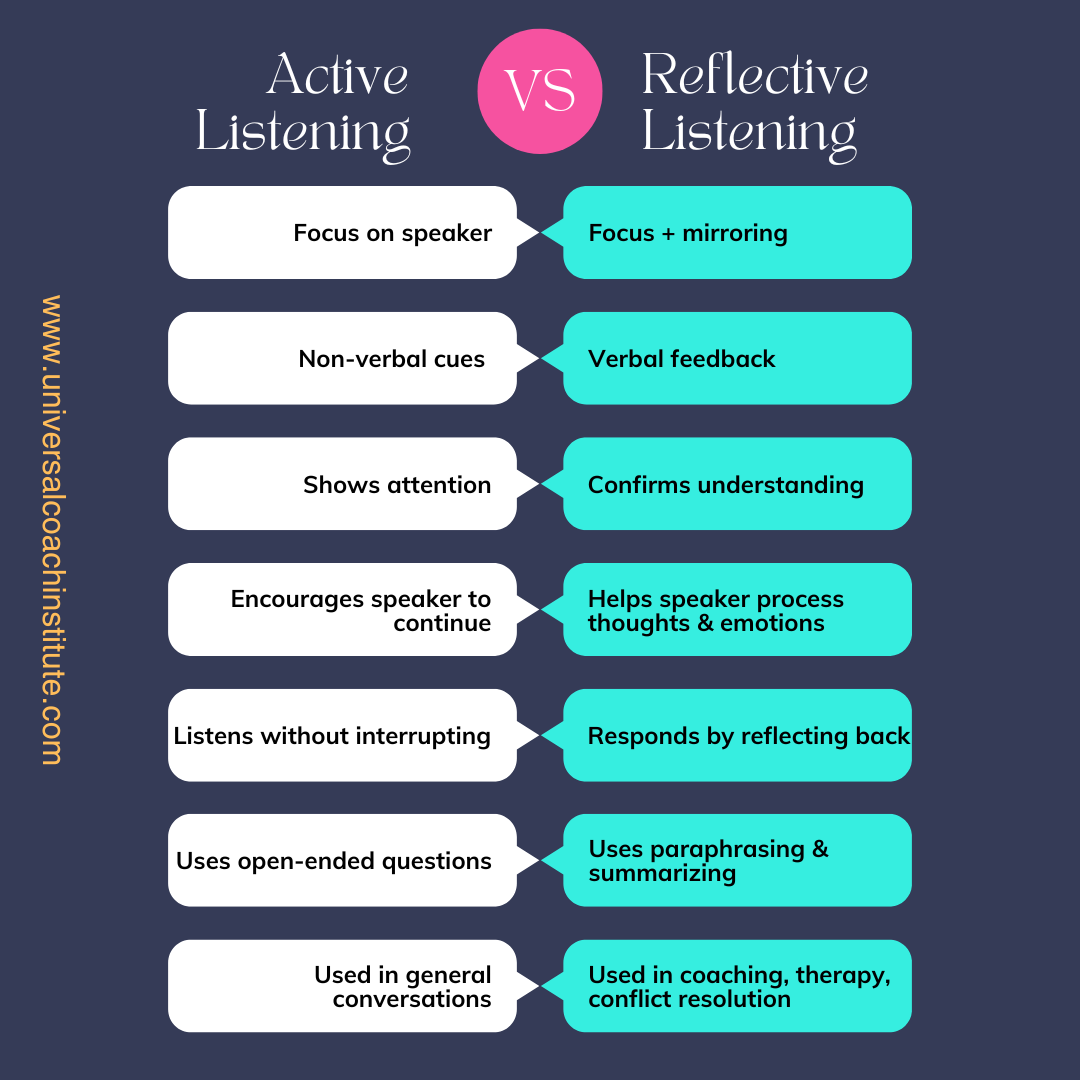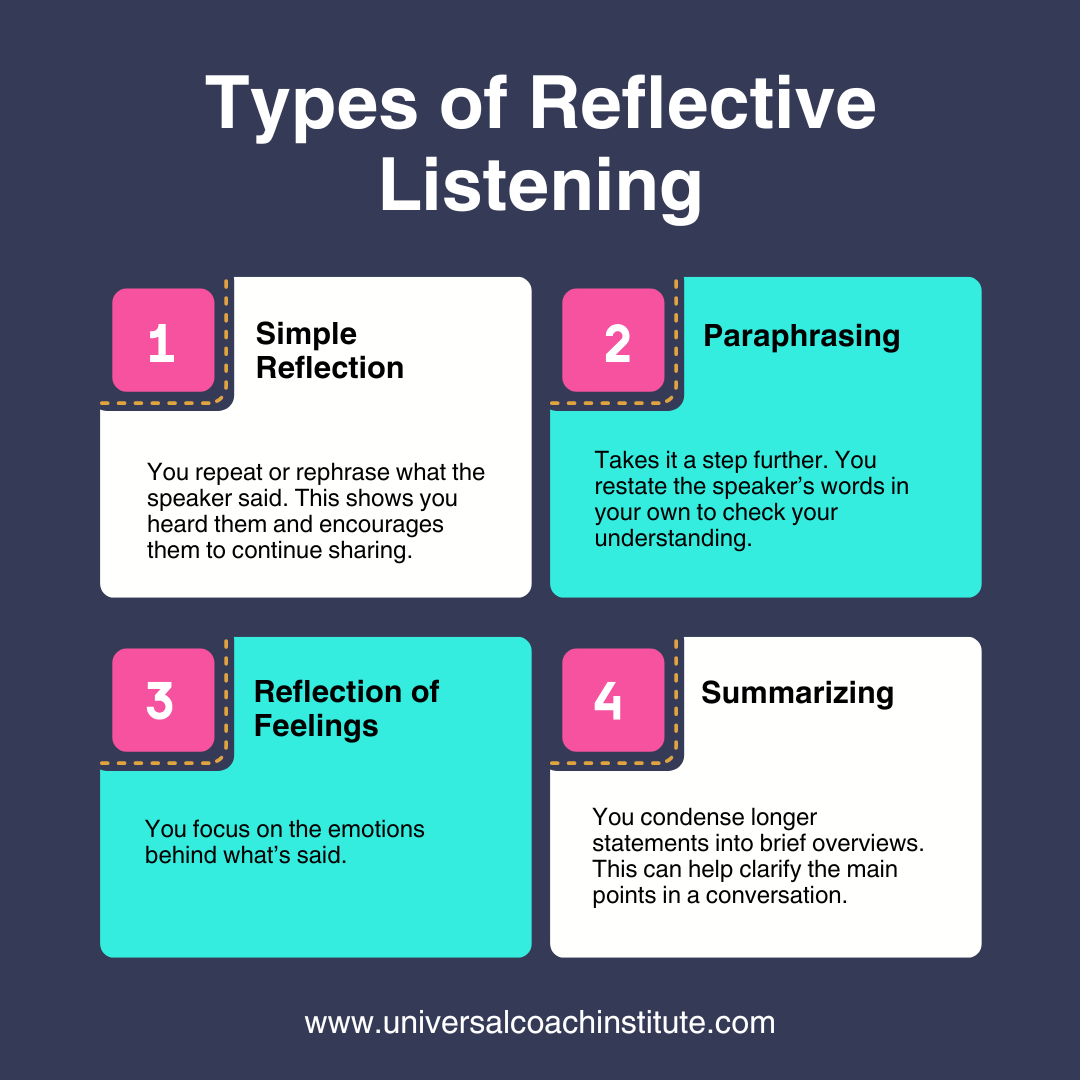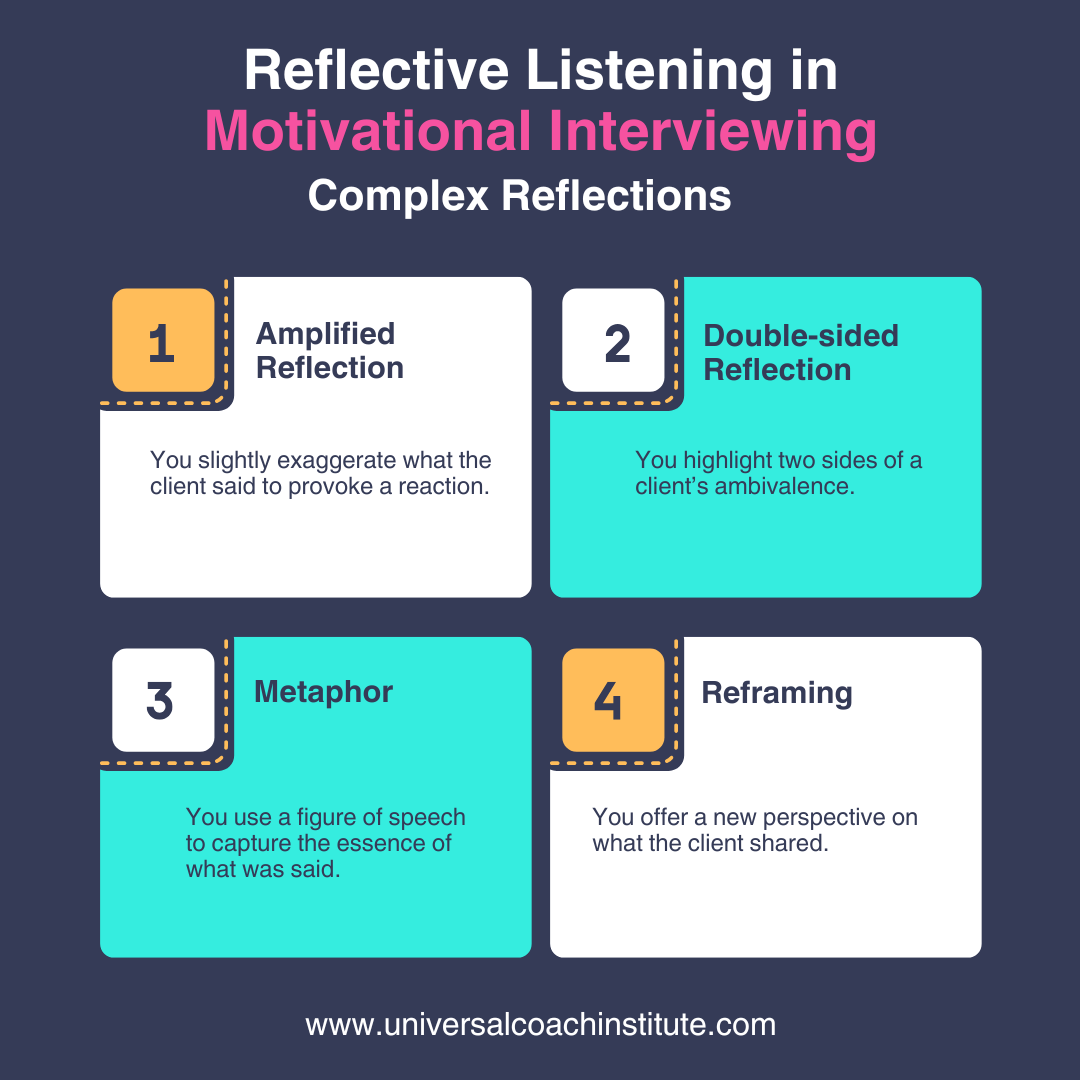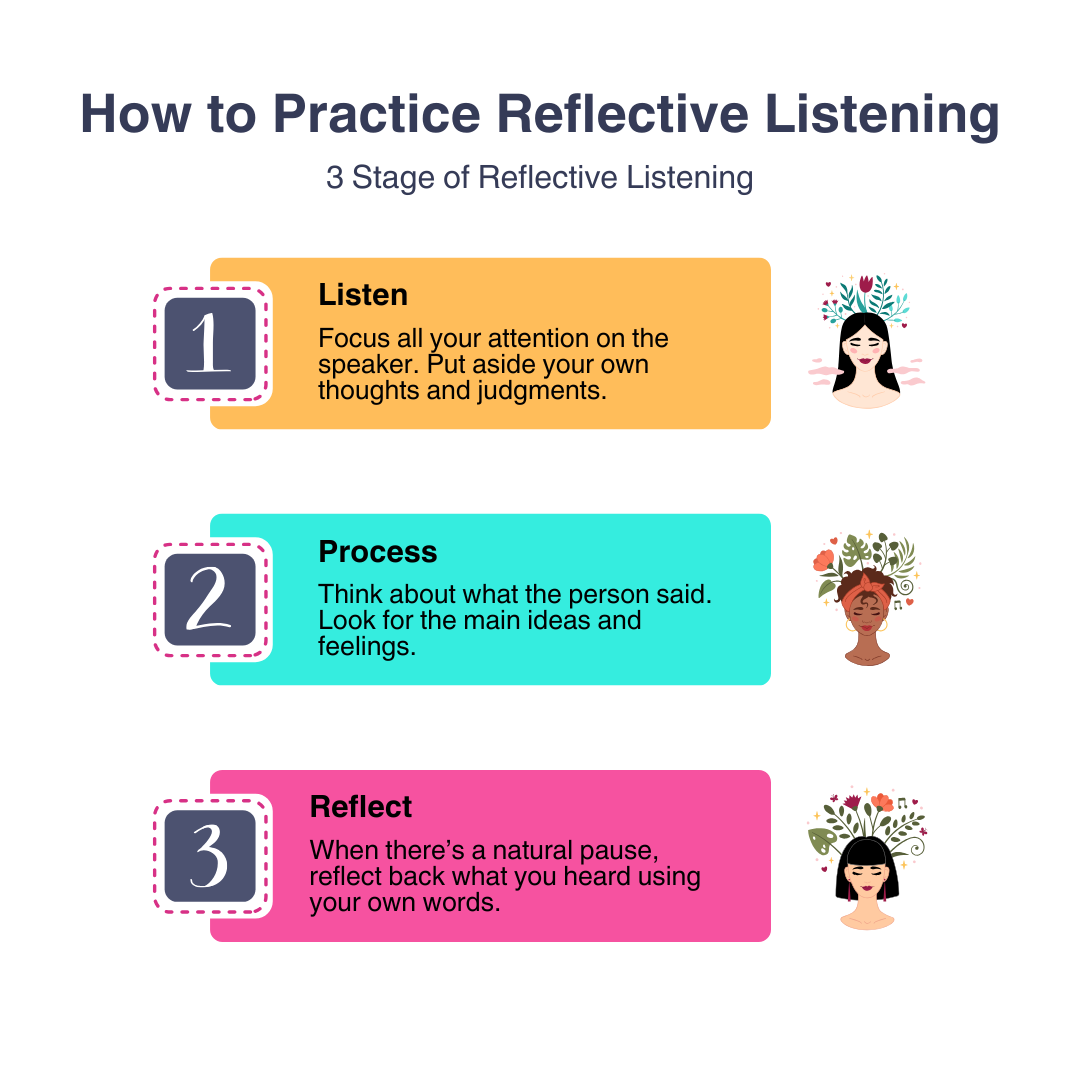Reflective listening means carefully paying attention to what someone says and then restating it in your own words. This shows you heard them and gives them a chance to clarify.
This blog post will teach you how to use reflective listening. You’ll learn tips to improve your skills and see how it can help in different situations.
By the end, you’ll be ready to listen more deeply and connect better with others.
In This Post
- 1 What is Reflective Listening?
- 2 What is an Example of Reflective Listening?
- 3 How is Reflective Listening Different from Active Listening?
- 4 Why is Reflective Listening Important?
- 5 What Are the Different Types of Reflective Listening?
- 6 Reflective Listening In Motivational Interviewing
- 7 How To Practice Reflective Listening
- 8 Reflective Listening Worksheet
- 9 Common Barriers To Reflective Listening
- 10 Practical Applications Of Reflective Listening
- 11 Frequently Asked Questions
- 12 Conclusion
What is Reflective Listening?
Reflective listening is a powerful communication technique that helps create understanding between people. It involves carefully paying attention and mirroring back what you hear.
Reflective Listening Definition
Reflective listening means restating what the other person said in your own words. You focus on their message and feelings, not just the facts. This shows you’re trying to truly understand them.
When you use reflective listening, you:
- Give your full attention to the speaker
- Listen for the main ideas and emotions
- Restate what you heard in your own words
- Check if you understood correctly
This technique helps build trust and clarity. It can be useful in many situations, like:
- Coaching sessions
- Therapy appointments
- Work meetings
- Personal relationships
What is an Example of Reflective Listening?
Example:
- Speaker: “I feel really overwhelmed with all these deadlines.”
- Listener: “It sounds like you’re feeling stressed because you have too many deadlines at once.”
This reflection shows that the listener understands both the content and emotion behind the speaker’s words.
How is Reflective Listening Different from Active Listening?
Active listening and reflective listening are two important skills for coaches and therapists. While they share similarities, there are key differences between them.
Active listening involves focusing fully on the speaker. You give your undivided attention and show you’re engaged through body language and verbal cues.
This may include nodding, making eye contact, and using short phrases like “I see” or “go on.”
Reflective listening takes active listening a step further. You not only pay attention but also mirror back what you’ve heard.
This helps check your understanding and shows the speaker you’re truly listening.
Active Listening Vs. Reflective Listening
Here’s a quick comparison:
| Active Listening | Reflective Listening |
|---|---|
| Focus on speaker | Focus + mirroring |
| Non-verbal cues | Verbal feedback |
| Shows attention | Confirms understanding |
When you use reflective listening, you might say things like:
- “It sounds like you’re feeling…”
- “If I understand correctly, you’re saying…”
- “So, what you mean is…”
This technique helps build trust and encourages the speaker to open up more. It’s a valuable tool in both coaching and therapy settings.
Why is Reflective Listening Important?
Reflective listening plays a key role in coaching and therapy. It helps create trust and understanding between people.
General Importance
Reflective listening shows you care about what someone is saying. It helps you grasp their thoughts and feelings better.
When you reflect back what you hear, it lets the speaker know you’re paying attention. This makes them feel heard and valued.
Reflective listening also helps avoid misunderstandings. By checking that you heard correctly, you can clear up any confusion. This leads to better communication overall.
Using this skill builds stronger relationships. It creates a safe space for people to open up.
They feel more comfortable sharing when they know you’re truly listening.
Importance Of Reflective Listening In Coaching
Reflective listening is a coaching skill that helps you connect with your clients. It shows you’re focused on their needs and goals. This builds trust and makes clients more likely to follow your advice.
It also helps clients gain new insights. When you mirror back their words, they often hear things in a new way. This can lead to “aha” moments and breakthroughs.
The technique supports self-discovery in coaching. By reflecting, you help clients explore their own thoughts and feelings deeper.
This can lead to more meaningful changes and growth.
Importance Of Reflective Listening In Therapy
In therapy, reflective listening is a core skill. It helps create a strong bond between you and your clients. This bond is key for effective treatment.
The technique helps clients feel understood and accepted. This is crucial for healing and progress in therapy.
When clients feel heard, they’re more likely to open up about difficult topics.
Reflective listening also helps you pick up on hidden meanings or emotions.
By reflecting these back, you can help clients become more aware of their inner world.
This self-awareness is a big part of many types of therapy, like person-centered therapy.
What Are the Different Types of Reflective Listening?
Reflective listening comes in several forms. You can use different approaches depending on the situation and your goals.
Simple reflection:
You repeat or rephrase what the speaker said. This shows you heard them and encourages them to continue sharing.
- Speaker: “I’m feeling overwhelmed with work.”
- Listener: “You’re feeling overwhelmed.”
Paraphrasing:
Takes it a step further. You restate the speaker’s words in your own to check your understanding.
- Speaker: “I’m struggling to keep up with deadlines.”
- Listener: “It sounds like you’re finding it hard to manage your workload.”
Reflection of feeling:
You focus on the emotions behind what’s said.
- Speaker: “I just can’t seem to get things right lately.”
- Listener: “You’re feeling frustrated and maybe a bit discouraged.”
Summarizing:
You condense longer statements into brief overviews. This can help clarify the main points in a conversation.
- Speaker: “I’m stressed about work, not sleeping well, and worried I’ll burn out.”
- Listener: “So, you’re feeling stressed, exhausted, and concerned about burnout.”
Here’s a quick breakdown of these types:
| Type | Description |
|---|---|
| Simple | Repeat or rephrase |
| Paraphrase | Restate in own words |
| Feeling | Focus on emotions |
| Summarize | Condense main points |
There are also different complex reflective listening types that are used in Motivational Interviewing.
Reflective Listening In Motivational Interviewing
Reflective listening is a key skill in motivational interviewing. It encourages them to explore their thoughts and feelings more deeply.
Complex Reflections
Complex reflections go beyond simply repeating what a client says. They add meaning and show deeper understanding. Here are some types of complex reflections:
Amplified reflection:
You slightly exaggerate what the client said to provoke a reaction.
- Client: “I’ve failed at everything I’ve ever tried.”
- Coach: “So, you’ve never succeeded at anything in your entire life?”
Double-sided reflection:
You highlight two sides of a client’s ambivalence.
- Client: “I want to start my business, but I’m scared of failing.”
- Coach: “On one hand, you’re excited about starting, but on the other, fear is holding you back.”
Metaphor:
You use a figure of speech to capture the essence of what was said.
- Client: “I feel stuck and don’t know how to move forward.”
- Coach: “It sounds like you’re at a crossroads, unsure which path to take.”
Reframing:
You offer a new perspective on what the client shared.
- Client: “I made a mistake in my last project.”
- Coach: “It sounds like you learned something valuable for next time.”
Using these reflections, you can:
- Show empathy
- Build rapport
- Clarify meaning
- Encourage self-exploration
Practice these techniques to improve your motivational interviewing skills.
Start with simple reflections and gradually add more complex ones.
Your clients will feel more understood and open up more easily.
How To Practice Reflective Listening
To practice this skill, use the 3 stages.
The 3 Stages Of Reflective Listening
Stage 1: Listen
You focus all your attention on the speaker. Put aside your own thoughts and judgments.
Split your attention between the speaker’s words, tone, emotions, and body language. Put away distractions and focus on them.
Stage 2: Process
As they talk, listen carefully without interrupting. Take mental notes of key points and emotions they express.
You think about what the person said. Look for the main ideas and feelings.
Try to grasp the deeper meaning behind their words. Consider what they might not be saying directly.
Stage 3: Reflect
When there’s a natural pause, reflect back what you heard using your own words.
Sum up the key points.
Check if you understood correctly.
This shows the speaker you’re truly listening and helps clear up any misunderstandings.
Try saying things like:
- “It sounds like you feel…”
- “What I’m hearing is…”
- “Let me make sure I understand…”
Keep your reflections brief and to the point. Check if you got it right by asking, “Did I understand that correctly?” This gives them a chance to clarify if needed.
These stages aren’t always neat and separate. They often overlap and flow into each other.
The goal is to create a loop of understanding between you and the speaker.
Reflective listening takes practice. At first, it might feel awkward or forced.
But with time, it becomes more natural. Your reflections will get more accurate and helpful.
Remember, good reflections go beyond just repeating words. They capture the essence of what was said.
They show empathy and help the speaker feel heard and understood.
- Note: Be patient and give the other person time to respond. Don’t rush to fill silences. Allow space for self-exploration and personal growth.
Practice often to improve your skills. Try reflective listening in daily conversations with friends and family. The more you use it, the more natural it will become in your coaching or therapy work.
Reflective Listening Worksheet
This Reflective Listening Practice Worksheet is designed to help you develop and refine your listening skills through structured exercises. It covers key components of reflective listening, different types (such as paraphrasing, summarizing, and feeling reflection), and practical exercises to apply these techniques in real conversations. The worksheet includes step-by-step activities, real-life application prompts, and a reflection journal to track your progress. By practicing these skills, you can enhance your communication, build stronger relationships, and improve your ability to understand and validate others effectively.
Download the Reflective Listening Practice Worksheet
Common Barriers To Reflective Listening
You may face several obstacles when trying to listen reflectively. Distractions can pull your focus away from the speaker.
Your own thoughts and judgments might interfere with truly hearing the other person.
Feeling rushed or impatient can make it hard to stay present.
Assuming you know what someone will say next often leads to missing important details.
Wanting to offer advice or share your own experiences can get in the way of listening fully.
Strong emotions like anger or anxiety may cloud your ability to reflect accurately.
Fatigue and stress can reduce your capacity to concentrate on reflective listening.
Cultural differences in communication styles might create misunderstandings.
Fear of silence or discomfort with pauses could push you to speak too quickly.
To improve your reflective listening:
- Minimize distractions
- Practice patience
- Notice your own thoughts without judgment
- Stay curious about the speaker’s perspective
- Focus on understanding rather than responding
Remember, reflective listening takes effort and practice. Be patient with yourself as you work to overcome these common barriers.
Practical Applications Of Reflective Listening
Reflective listening helps build trust and understanding in many areas of life. It improves communication and relationships in both personal and professional settings.
In Personal Relationships
You can use reflective listening with your family and friends.
- Partner – When your partner shares concerns, try repeating back what you heard. Say things like, “It sounds like you’re feeling stressed about work.” This shows you’re paying attention.
- Children – Reflective listening helps kids feel heard. If your child is upset, you might say, “You’re angry because you can’t have ice cream before dinner.” This validates their feelings.
- Conflicts – Reflective listening also works well when solving conflicts. When arguing with a friend, restate their point of view. This makes them feel understood and can lead to compromise.
In Professional Settings
At work, reflective listening improves teamwork and productivity.
- Employees – As a manager, you can use it in meetings. When an employee suggests an idea, repeat it back to them. This shows you value their input.
- Customer Service – Reflective listening also helps in customer service. If a client complains, summarize their issue. Say, “So you’re upset because your order arrived late.” This can calm angry customers.
- Sales – In sales, use reflective listening to understand client needs. Repeat back what they say they want. This builds trust and helps you offer the right products or services.
In Coaching, Counseling, And Motivational Interviewing
Coaches and counselors rely on reflective listening to help clients feel heard and explore their thoughts. You might say, “It seems like you’re worried about changing careers.” This can lead to deeper discussions.
In therapy, reflective listening builds rapport. It shows empathy and helps clients open up. Therapists often restate what clients say to check understanding.
Motivational interviewers use reflective listening to guide change. They might say, “You want to quit smoking, but you’re scared of withdrawal.” This helps clients see their own reasons for change.
Frequently Asked Questions
How does reflective listening impact emotional intelligence?
Reflective listening improves emotional intelligence by:
- Enhancing self-awareness and social awareness.
- Strengthening empathy and emotional regulation.
- Improving communication and interpersonal skills.
Is reflective listening a learned skill?
Yes! Reflective listening is a skill that can be learned and improved with practice. Being mindful, patient, and intentional in conversations helps develop this skill.
Are there any exercises to practice reflective listening?
Yes! Try these exercises:
- Partner Practice: Have a conversation where one person speaks for a few minutes, and the other must only reflect back.
- Role-Playing: Practice reflecting emotions and content in different scenarios (e.g., workplace, family, relationships).
- Journaling: Write down conversations and analyze how you could improve your reflective listening.
Can reflective listening be overused?
Yes. Overusing reflective listening, especially in a robotic or forced way, may seem unnatural. Balance it with other forms of active listening, such as asking open-ended questions and validating emotions.
Conclusion
Reflective listening is a key skill for coaches and therapists. It helps build trust and understanding with clients. By using this technique, you can show you’re truly hearing what they say.
Practice makes perfect with reflective listening. Try it out in your daily life. Notice how it changes your conversations. You’ll likely find people open up more when they feel heard.
Remember to focus on the speaker’s feelings and meanings. Don’t just repeat their words. Show empathy and validate their experiences. This creates a safe space for deeper exploration.
Reflective listening takes time to master. Be patient with yourself as you learn. Your clients will appreciate your efforts to truly understand them. Keep refining your skills and watch your relationships grow stronger.







